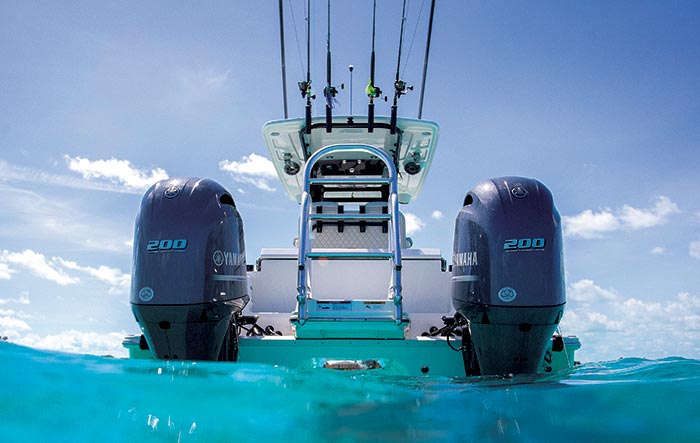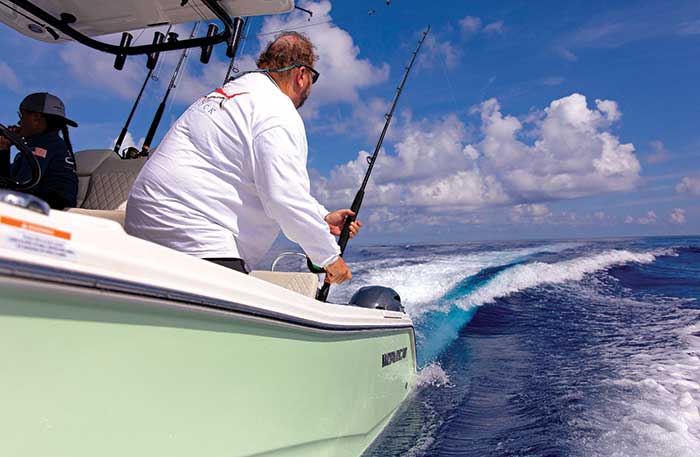Advertisement
Planing powercats deliver the high speeds dayboaters and weekend anglers crave — but without so much pounding in choppy seas.

The air cushion created between the two hulls dramatically reduces wave impact at running speeds. (Photo: World Cat)
Powercats are different beasts than sailing cats, and the powercats you're most likely to see on your local waters are those in the 20- to 40-foot range (like my 22-foot Glacier Bay). Unlike the big cruising powercats, which are more like cat trawlers with top ends maybe a little over 20 mph, smaller cats have planing hulls that perform much like today's modern powerboats.
Depending on the engine package, there are a few cats that top out in the lower 30s, lots in the lower 40s, some in the 50s, and a few that break 70 or even 80 mph.
While a similar length monohull may have a 40-mph cruising speed in a 2-foot chop, the monohull captain will pull back the throttles and cruise at 30 to avoid being beaten up. The cat guy, on the other hand, may be able to keep on doing 40 thanks to the smoother ride. But having two hulls underfoot does create some interesting similarities in how these different types of boats react to input from the helm. So you'll see a few of the tips here mirror those used for sailing or cruising catamarans. Whatever type of cat you may be captaining, remember the following:
- Center the wheel and use only the throttles to control the boat. Powercats have their engines exceptionally widely spaced apart, and are far more responsive than monohulls when steered via throttles. Generally speaking, turning the steering wheel will only serve to reduce the effectiveness of working the throttles. This, of course, is assuming you have two engines. There are a few rare cats with one engine.
- At identical rpm, the engine in forward will create more thrust than the engine in reverse. So even if the throttles are set evenly when opposed, the boat will likely slide forward a bit as opposed to spinning in its own length. As a result, when attempting to speed up the maneuver it's usually best to favor giving the reversed engine extra oomph as opposed to the one in forward (assuming you don't want to move forward while turning the boat).
- Check the speed and direction of the wind before docking, and remember that some cats, particularly those with low draft, can be blown around more easily than many monohulls as there may be less hull below the waterline.
- When docking in a new slip for the first time with lines that haven't been preset, bear in mind that once you're docked, securing the boat can be difficult in some situations because few powercats have centered cleats. Most will have a single cleat on either side, in some cases obstructed by a bow rail and/or pulpit, which can make crossing lines difficult.
- Never shut those engines down until all the lines are secured. Again, remember that many cats can get blown out of kilter faster than the average monohull, and if you don't have lines preset, it may take a moment to figure out how to best secure them. Many a captain has done a perfect docking job and then shut off the engines, only for a gust of wind to push the boat right back out of the slip before the lines can be tied. Keep those engines running until the boat is 100% secure so you can apply power, if necessary, to maintain position.
Why Two Hulls?
Like all boats, catamarans come with distinct advantages (smooth ride, draft), and areas of compromise (docking, turning). Regardless of design aesthetics, the first question is usually: Why two hulls?
Mike Myers, vice president of product development for World Cat explains: "Catamaran hulls experience little to no drag or resistance to get on plane, resulting in greater fuel economy. They have a steady rise in speed and fuel burn with little to no spikes in fuel consumption."Planing powercats have a unique trait — which many cat lovers consider the top advantage over monohulls — the impact-absorbing cushion of air created by a compression tunnel between hulls.
And when it comes to beam, catamarans' parallel hulls create reliable stability, which helps to avoid heeling and capsizing, and greatly reduces the vessel roll at rest and at trolling speeds.
"Many boats are primarily designed around comfort for the captain. This usually means anyone at the front or sides of the boat takes most of the jostling,"Myers says. "The catamaran-style hull delivers ride comfort, smoothness, load distribution, and stability."That stability draws anglers to powercats of typically 20 to 40 feet; and cruisers to sailing cats 40 to 60 feet and beyond.
— Rich Armstrong
Taming The Cat
When it comes to handling powercats in open waters, the most important thing to remember is that all boats are different. Just as you wouldn't lump the handling characteristics of all monohulls together, the same goes for powercats. But many have a few common traits to consider.
- Some powercats have relatively low buoyancy in the bow compared to monohulls, as many have very narrow hull entries. As a result, in some cases, idling into a sea can allow waves to break over the bow. Gaining some headway so the bow rises a bit and packs air into the tunnel can alleviate the issue.
- Some planing powercats will run smoother at faster speeds than slower speeds, as they compress air in the tunnel between the two hulls. In these cases, speeding up may actually provide a more comfortable ride in some sea states as compared to slowing down. Depending on your boat, its tunnel may result in other differences from the monohull that you may be familiar with. Learning about these will improve you experience.
- Some powercats display a "snap roll,"which is a very fast righting motion that can rock the boat uncomfortably, especially when drifting in a beam sea. In these cases, people who may want to drift often (such as anglers) will sometimes deploy a drift sock off the bow to reduce rocking and rolling.

Photo: World Cat
- In general, powercats are often more weight-sensitive than monohulls, especially when the bow is loaded down. It's always best to be aware of how you're loading your boat, and if the tunnel is slapping or the bow is digging into waves, consider shifting weight aft.
- Some powercats, particularly older models, lean out in a turn rather than banking in. There's no way to eliminate this phenomenon (although trimming up an outboard engine when initiating a turn may reduce it a bit), so it's important to give passengers a warning to hold on before making any aggressive maneuvers.
- "Sneezing,"or blowing a puff of mist out the front of the tunnel that the boat then runs through (getting everyone aboard damp), is a phenomenon associated with some powercats. In many cases, trimming the bow up a bit will significantly reduce or even eliminate sneezing.
